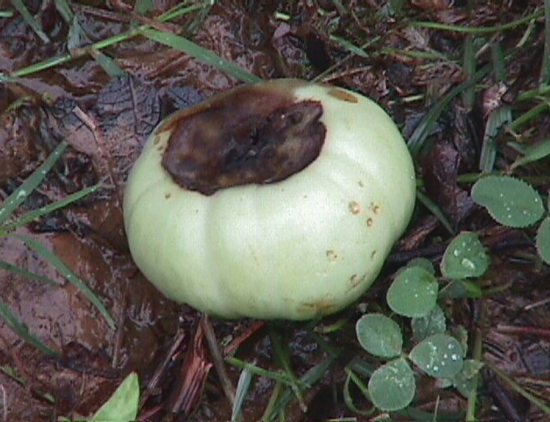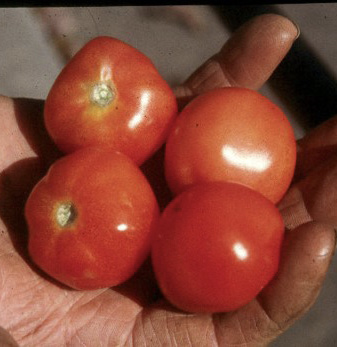Tomato Troubles: Common Problems with Tomatoes
Tomatoes are the most popular vegetable to grow in Mississippi in both home gardens and commercial production. Not surprisingly, many questions arise from gardeners and commercial growers about various problems that occur during the season.
This publication discusses some of the most common disorders, methods of prevention, and sources of more information. Hopefully you will see very few, if any, of these situations in your own tomato plants this year.
Misshapen Fruit
Misshapen fruit are common in home gardens. There are several factors that cause misshapen fruit, but the most likely is low temperature.
Tomato fruit will develop the best shape if the temperature is above the mid-60s (°F). Lower temperatures cause ridged fruit (a bumpy shoulder) and catfacing (ugly bottom of fruit; see below). Planting a little later, when temperatures are higher, will avoid some of these problems.
Some varieties are more prone to produce misshapen fruit. Fruit of the larger beefsteak types as well as many of the older heirloom varieties are commonly misshapen.
Blossom-End Rot
Blossom-end rot (BER) is probably the most common problem across all types of production (home garden, field, and greenhouse). It appears as a dry, leathery (not mushy), dark brown or black area, usually at or near the bottom of the fruit. BER can sometimes occur on the side of fruit, and occasionally only on the inside, so the BER is hidden until the tomato is sliced open. Sometimes the spot is sunken, and these tomatoes often ripen before all others.


BER is not caused by an infectious agent (pathogen) and is, therefore, not a disease. It is a physiological disorder caused by lack of adequate calcium in developing fruit. Most Mississippi soils have enough calcium for tomato fruits to develop properly, but it is a good idea to have the soil tested to make sure.
A tissue analysis during the season can also help to identify nutritional deficiencies and help ensure that plants are absorbing needed nutrients for proper growth and development. Submit soil and tissue samples to the MSU Extension Soil Testing Lab (http://extension.msstate.edu/agriculture/soils/soil-testing) for analysis. Visit the lab website for the most up-to-date fees and submission forms. Instructions on how to collect and submit soil and tissue samples are available in MSU Extension publications IS346 Soil Testing for the Farmer, IS1294 Soil Testing for the Homeowner, and P1224 Plant Analysis Sampling Instructions.
It’s common to see BER on the first tomatoes of the season. While low calcium in fruit is the cause, the real culprit is often drought. Without a steady supply of water, the tiny root hairs dry out, which limits the amount of calcium the plants can absorb and supply to developing fruit. Don’t let plants wilt between waterings. The best way to prevent damage to root hairs caused by drying out is to provide consistent water and to mulch around plants.
BER can be especially problematic to tomatoes grown in containers because they have a tendency to dry out more easily. Be sure to provide mulch around the tomatoes to protect the roots. Some varieties are more susceptible to BER than others. If the problem continues, try planting a different variety the following season.
It is important to note that while BER is not a disease, fungi are often observed on damaged tissue as secondary infections. These fungi are commonly opportunistic fungi and not pathogens that cause common tomato diseases. Additionally, BER is sometimes confused with the disease buckeye rot, in which brown, circular lesions develop on fruit. In contrast to lesions associated with BER, buckeye rot lesions often appear oily and have concentric rings. Fruits that develop buckeye rot are often located close to the ground. For additional information on buckeye rot, see Publication 3175 Common Diseases of Tomatoes.
Fruit Cracking
Cracking is a common problem in tomatoes when growing conditions are not perfect. Cracks can be described as radial—those that radiate from the stem end and move downward—and concentric—those that form rings around the stem end of the fruit.
Both types of cracks are signs of inconsistent water content in the plant. Uneven watering will promote fruit cracking, so be sure that plants are getting enough water. Cracking can also be promoted by very fast growth, excessive moisture (rain or heavy watering) after a dry period, high temperature, a large difference between daytime and nighttime temperatures, and inadequate nutrition.
Not all cracking can be avoided, but the severity can be lessened by mulching, maintaining an even water supply, and using an adequate fertilizer program. Some varieties are also resistant to cracking.

Catfacing
Catfacing is a condition in which the fruit becomes malformed or irregularly shaped, often with brown scars at the blossom end that sometimes run up the sides of the fruit. The blossom end of the fruit will often be puckered with deep crevices. This is different from BER, which shows up as dark brown areas on the bottoms of fruit but without the puckering or crevices.
In its most severe form, the bottoms of fruit seem to be turned inside out so that the seed cavity is visible on the outside. It usually only affects the earliest fruit set due to the cooler temperature at that time; later-harvested fruit are generally not affected. Catfacing does not affect the edibility of the fruit. The scars can be cut off and the rest of the tomato eaten.
Catfacing is almost always caused by cool temperatures during pollination and early growth. Some varieties are more susceptible than others. The only management methods are to plant later in the season, use resistant varieties, and use plastic or spun-bound row covers to increase temperature on cool days and nights.

Leaf Rolling
Leaf rolling is the term used for moderately or severely curled leaves, with the edges of leaves rolling inward. In severe cases, the leaves are so tightly rolled that they appear to be green tubes. This often occurs after the plant has set a heavy load of fruit. Heavy pruning and wet soils can also cause leaf rolling. Leaf rolling most often begins on the older leaves but can affect the entire plant.
This condition is harmless and should not affect yield or fruit quality. Pruning less heavily and planting tomatoes in a well-drained area can help to reduce the occurrence of leaf rolling.

Yellowing of Leaves (Chlorosis)
Chlorosis, or leaf yellowing, can be caused by several factors. The following are the most common:
- Shading. As plants mature, the bottom leaves become heavily shaded and naturally turn yellow as they age. This does not indicate a problem with the plant. These yellowing leaves are no longer productive and should be removed to improve air circulation.
- Low nitrogen* or potassium*. If the nitrogen or potassium level in the plant is too low, yellowing will occur. Nitrogen deficiency appears as a general yellowing of the entire plant, affecting both old and new leaves. Potassium deficiency appears as bright yellow leaf margins, or edges, on otherwise green leaves. Potassium deficiency affects mostly older leaves.
- Low magnesium*. Low magnesium appears as interveinal yellowing (yellowing between the veins) on older leaves. If you suspect magnesium deficiency, spray 2 tablespoons per gallon of magnesium sulfate (Epsom salt) on the plants. See if they “green up” in a few days.
- Diseases. Many diseases also cause chlorosis or yellowing of leaves. This symptom often occurs along with other symptoms, such as leaf spots or wilting. For additional information about diseases, see Publication 3175 Common Diseases of Tomatoes.
*A tissue analysis is recommended for all suspected nutrient problems.

Uneven Ripening
Uneven ripening includes green stripes, streaks, or blotches; stars on the bottoms of fruit; and yellow or green shoulders. Sometimes, one wall or one portion of the tomato will remain green or white even after the rest of the tomato turns red.
This problem may be caused by a number of factors, so the exact cause can be hard to determine. Most likely causes are high fertility (usually nitrogen), low potassium, high temperature (the red pigment, lycopene, is killed around 93°F), infection by certain viruses, and sweetpotato whitefly feeding.
Be sure to maintain adequate nutrition by soil testing and applying fertilizer according to the recommendations. A tissue analysis can help reveal if the cause is nutritional. For help, visit the MSU Extension Soil Testing Lab online and see Publication 1224 Plant Analysis Sampling Instructions.

Sunscald
Sunscald appears as a white or tan blistered area at or near the top of the fruit. This is similar to sunburn in people. In tomatoes, the affected area can turn leathery and be invaded by pathogens that cause rot, but it often remains dry.
To prevent sunscald, do not prune heavily, especially at the tops of plants, and maintain proper nutrition and pest management to provide good, leafy coverage for the fruit.

Blossom Drop
Blossom drop occurs when flowers abort and fall from the plant rather than setting fruit. This can greatly reduce yield. Any type of stress on the flower can prevent fruit set, including these common stressors:
- Too much nitrogen. Excessive nitrogen often creates very healthy-looking, lush, dark green plants, but few flowers or fruit. This is the most common cause of stress by far, so be careful not to overdose tomatoes with fertilizer, especially early in the season before fruit set has occurred.
- High temperature. Pollen is sterilized at or around 93°F. Therefore, even though flowers are pollinated, they are not fertilized, so fruit will not develop.
- Low temperature. Temperatures lower than 55°F are less than optimal for flower set.
- Drought stress. Lack of water can cause plants to wilt and drop their blossoms.
- Salt stress. If too much fertilizer has been applied, the salt level in the root zone can become so high that it causes plant stress.

Notes
- Lack of honey bees does not cause blossom drop. Tomatoes are wind-pollinated and do not depend on bees, though bees do assist in pollination.
- Certain varieties are sold as “cold set” or “hot set” varieties and will set fruit more consistently at the designated extremes in temperature. Home gardeners should refer to Extension Publication 3744 Variety Recommendations for Mississippi Vegetable Gardens for more information. Commercial growers can find heat-tolerant varieties recommended for Mississippi in the latest edition of the Southeast U.S. Vegetable Crop Handbook (available in print and at www.vegcrophandbook.com).
Small Fruit
Getting small fruit is not as distressing as getting no fruit but can still be a serious problem. Beefsteak varieties vary in size from just under a half-pound to well over a pound. Cherry and grape tomato varieties are much smaller.
These are possible causes of undersized fruit:
- Lack of water.
- High temperature. This problem is very common in the hot, humid Southeast from late spring through early fall.
- Shading. Be sure plants are not heavily shaded by large trees or structures.
- Mislabeled plants. Tomato sizes vary among varieties. Although rare, plants are sometimes mislabeled during greenhouse production and sold under the wrong name.

The information given here is for educational purposes only. References to commercial products, trade names, or suppliers are made with the understanding that no endorsement is implied and that no discrimination against other products or suppliers is intended.
Publication 2975 (POD-12-22)
Revised by Rebecca A. Melanson, Associate Extension Professor, Plant Pathology, Central Mississippi Research and Extension Center, and Christine E. H. Coker, Research and Extension Professor, Coastal Research and Extension Center. Originally prepared by Richard Snyder, PhD, Extension/Research Professor, Central Mississippi Research and Extension Center.
The Mississippi State University Extension Service is working to ensure all web content is accessible to all users. If you need assistance accessing any of our content, please email the webteam or call 662-325-2262.



